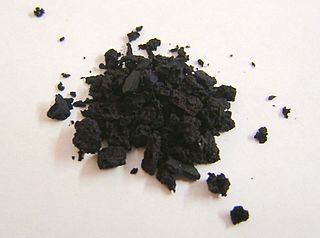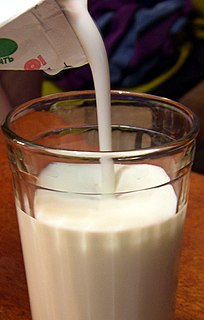Related Research Articles

Dairy products or milk products are a type of food produced from or containing the milk of mammals. They are primarily produced from mammals such as cattle, water buffaloes, goats, sheep, camels and humans. Dairy products include food items such as yogurt, cheese and butter. A facility that produces dairy products is known as a dairy, or dairy factory. Dairy products are consumed worldwide, with the exception of most of East and Southeast Asia and parts of central Africa.

Lactose is a disaccharide. It is a sugar composed of galactose and glucose subunits and has the molecular formula C12H22O11. Lactose makes up around 2–8% of milk (by weight). The name comes from lac (gen. lactis), the Latin word for milk, plus the suffix -ose used to name sugars. The compound is a white, water-soluble, non-hygroscopic solid with a mildly sweet taste. It is used in the food industry.

Lactic acid fermentation is a metabolic process by which glucose and other six-carbon sugars are converted into cellular energy and the metabolite lactate, which is lactic acid in solution. It is an anaerobic fermentation reaction that occurs in some bacteria and animal cells, such as muscle cells.

An agar plate is a Petri dish that contains agar as a solid growth medium plus nutrients, used to culture microorganisms. Sometimes selective compounds are added to influence growth, such as antibiotics.

Lactococcus lactis is a Gram-positive bacterium used extensively in the production of buttermilk and cheese, but has also become famous as the first genetically modified organism to be used alive for the treatment of human disease. L. lactis cells are cocci that group in pairs and short chains, and, depending on growth conditions, appear ovoid with a typical length of 0.5 - 1.5 µm. L. lactis does not produce spores (nonsporulating) and are not motile (nonmotile). They have a homofermentative metabolism, meaning they produce lactic acid from sugars. They've also been reported to produce exclusive L-(+)-lactic acid. However, reported D-(−)-lactic acid can be produced when cultured at low pH. The capability to produce lactic acid is one of the reasons why L. lactis is one of the most important microorganisms in the dairy industry. Based on its history in food fermentation, L. lactis has generally recognized as safe (GRAS) status with few case reports of being an opportunistic pathogen.

Bacteriological water analysis is a method of analysing water to estimate the numbers of bacteria present and, if needed, to find out what sort of bacteria they are. It represents one aspect of water quality. It is a microbiological analytical procedure which uses samples of water and from these samples determines the concentration of bacteria. It is then possible to draw inferences about the suitability of the water for use from these concentrations. This process is used, for example, to routinely confirm that water is safe for human consumption or that bathing and recreational waters are safe to use.

Coliform bacteria are defined as rod-shaped Gram-negative non-spore forming and motile or non-motile bacteria which can ferment lactose with the production of acid and gas when incubated at 35–37°C. Due to the limited ability of certain coliform bacteria to ferment lactose, the definition has changed to bacteria containing the enzyme B-galactosidase. They are a commonly used indicator of sanitary quality of foods and water. Coliforms can be found in the aquatic environment, in soil and on vegetation; they are universally present in large numbers in the feces of warm-blooded animals. While coliforms themselves are not normally causes of serious illness, they are easy to culture, and their presence is used to indicate that other pathogenic organisms of fecal origin may be present. Such pathogens include disease-causing bacteria, viruses, or protozoa and many multicellular parasites. Coliform procedures are performed in aerobic or anaerobic conditions.

Eosin methylene blue is a selective stain for Gram-negative bacteria. EMB contains dyes that are toxic to Gram-positive bacteria. EMB is the selective and differential medium for coliforms. It is a blend of two stains, eosin and methylene blue in the ratio of 6:1. EMB is a differential microbiological medium, which slightly inhibits the growth of Gram-positive bacteria and provides a color indicator distinguishing between organisms that ferment lactose and those that do not. Organisms that ferment lactose display "nucleated colonies"—colonies with dark centers.

A growth medium or culture medium is a solid, liquid or semi-solid designed to support the growth of microorganisms or cells, or small plants like the moss Physcomitrella patens. Different types of media are used for growing different types of cells.

MacConkey agar is an indicator, a selective and differential culture medium for bacteria designed to selectively isolate Gram-negative and enteric bacilli and differentiate them based on lactose fermentation. The crystal violet and bile salts inhibit the growth of Gram-positive organisms which allows for the selection and isolation of gram-negative bacteria. Enteric bacteria that have the ability to ferment lactose can be detected using the carbohydrate lactose, and the pH indicator neutral red.
Sorbitol MacConkey agar is a variant of traditional MacConkey agar used in the detection of E. coli O157:H7. Traditionally, MacConkey agar has been used to distinguish those bacteria that ferment lactose from those that do not. This is important because gut bacteria, such as Escherichia coli, can typically ferment lactose, while important gut pathogens, such as Salmonella enterica and most shigellas are unable to ferment lactose. Shigella sonnei can ferment lactose, but only after prolonged incubation, so it is referred to as a late-lactose fermenter.

Litmus is a water-soluble mixture of different dyes extracted from lichens. It is often adsorbed onto filter paper to produce one of the oldest forms of pH indicator, used to test materials for acidity.

Bromocresol purple (BCP) or 5′,5″-dibromo-o-cresolsulfophthalein, is a dye of the triphenylmethane family and a pH indicator. It is colored yellow below pH 5.2, and violet above pH 6.8. In its cyclic sulfonate ester form, it has a pKa value of 6.3, and is usually prepared as a 0.04% aqueous solution.

Mannitol salt agar or MSA is a commonly used selective and differential growth medium in microbiology. It encourages the growth of a group of certain bacteria while inhibiting the growth of others. This medium is important in medical laboratories as one method of distinguishing pathogenic microbes in a short period of time. It contains a high concentration of salt (NaCl), making it selective for most Gram-negative and some Gram-positive bacteria since this level of salt is inhibitory to most other bacteria. It is also a differential medium for mannitol-fermenting staphylococci, containing carbohydrate mannitol and the indicator phenol red, a pH indicator for detecting acid produced by mannitol-fermenting staphylococci. Staphylococcus aureus produces yellow colonies with yellow zones, whereas other coagulase-negative staphylococci produce small pink or red colonies with no colour change to the medium. If an organism can ferment mannitol, an acidic byproduct is formed that causes the phenol red in the agar to turn yellow. It is used for the selective isolation of presumptive pathogenic (pp) Staphylococcus species.

The Triple Sugar Iron (TSI) test is a microbiological test roughly named for its ability to test a microorganism's ability to ferment sugars and to produce hydrogen sulfide. It is often used in the selective identification of enteric bacteria including Salmonella and Shigella.

Hektoen enteric agar is a selective and differential agar primarily used to recover Salmonella and Shigella from patient specimens. HEA contains indicators of lactose fermentation and hydrogen sulfide production; as well as inhibitors to prevent the growth of Gram-positive bacteria. It is named after the Hektoen Institute in Chicago, where researchers developed the agar.

Kefir or kephir, is a fermented milk drink similar to a thin yogurt that is made from kefir grains, a specific type of mesophilic symbiotic culture. The drink originated in the North Caucasus, Eastern Europe and Russia, where it is prepared by inoculating cow, goat, or sheep milk with kefir grains.

Cheese ripening, alternatively cheese maturation or affinage, is a process in cheesemaking. It is responsible for the distinct flavour of cheese, and through the modification of "ripening agents", determines the features that define many different varieties of cheeses, such as taste, texture, and body. The process is "characterized by a series of complex physical, chemical and microbiological changes" that incorporates the agents of "bacteria and enzymes of the milk, lactic culture, rennet, lipases, added moulds or yeasts, and environmental contaminants". The majority of cheese is ripened, save for fresh cheese.

Bifidobacterium is a genus of gram-positive, nonmotile, often branched anaerobic bacteria. They are ubiquitous inhabitants of the gastrointestinal tract, vagina and mouth of mammals, including humans. Bifidobacteria are one of the major genera of bacteria that make up the gastrointestinal tract microbiota in mammals. Some bifidobacteria are used as probiotics.
References
- ↑ Schierl, Elizabeth A.; Blazevic, Donna J. (August 1981). "Rapid Identification of Enterococci by Reduction of Litmus Milk". Journal of Clinical Microbiology. 14 (2): 227–228. PMC 271939 . PMID 6895080.
- 1 2 "Litmus Milk Medium Data Sheet" (PDF). Archived from the original (PDF) on 15 July 2011.
- ↑ "Litmus Milk Results and Meanings". clark.edu.